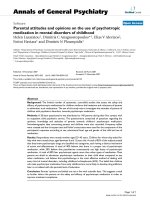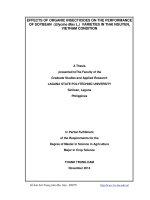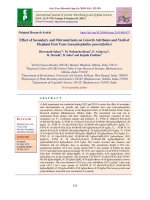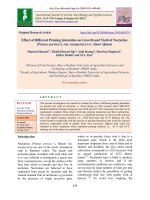Performance of Mulches and micronutrients on water use of broccoli (Brassica oleracea L var. Italica Plenck)
Bạn đang xem bản rút gọn của tài liệu. Xem và tải ngay bản đầy đủ của tài liệu tại đây (343.44 KB, 7 trang )
Int.J.Curr.Microbiol.App.Sci (2019) 8(1): 102-108
International Journal of Current Microbiology and Applied Sciences
ISSN: 2319-7706 Volume 8 Number 01 (2019)
Journal homepage:
Original Research Article
/>
Performance of Mulches and Micronutrients on Water Use of Broccoli
(Brassica oleracea L var. Italica Plenck)
B.V.G. Prasad* and S. Chakravorty
Department of Horticulture & PHT, Institute of Agriculture,
Visva-Bharati University, Sriniketan, West-Bengal, India-731236
*Corresponding author
ABSTRACT
Keywords
Broccoli,
Micronutrients,
Mulches, Water use
and yield
Article Info
Accepted:
04 December 2018
Available Online:
10 January 2019
The Field experiment was conducted during rabi season of 2014-15 and 2015-16 to find
out the response of mulches and micronutrients on growth and yield of broccoli with an
objective to estimate water use and water use efficiency of broccoli. The experiment was
laid out in split-plot design with three main plots (mulches), nine sub plots
(micronutrients) and twenty seven interaction treatments (mulches x micro nutrients) and
each treatment was replicated thrice. The results revealed that mulches and micronutrients
as well as their interaction significantly affected the water use and water use efficiency of
broccoli. The lowest water use (153.86 mm) and highest water use efficiency (76.36 kg ha
mm) were observed were with application of paddy straw mulch-7t.ha-1 along with
combined application of Zn-1%+B-0.5% in broccoli.
Introduction
Broccoli (Brassica oleracea L. var. Italica) is
one of the most nutritious of cole crops which
contains high amount of Vitamin-A
(9000IU/100g), protein (3.5%) (Friedman,
1996), antioxidants, phenolics, vitamins and
other
bioactive
compounds
(viz.,
sulphoraphane, total dietary fiber, minerals,
folates, etc.). Plant nutrition is one of the
prime considerations for getting higher yield
(Saha et al., 2010) and it was observed that
balanced application of fertilizers is the
prerequisite for obtaining higher yield and
better quality of broccoli (Brahma et al.,
2002). Micronutrients are essential for plant
growth and play an important role in balanced
crop nutrition. Among micronutrients, zinc
and boron are important for broccoli
production. Zinc is a precursor of auxins and it
helps formation of chlorophyll in leaves
thereby increases photosynthesis for better
growth and development of the plant (Torres,
1974). Deficiency of zinc led to development
of small sized heads with poor market price.
Boron
is
responsible
for
increased
translocation of photosynthates from source
(leaves) to sink (head) (Pandhawa and Bhail,
1976) and thus helps to attain high head
weight thereby high yield. The deficiency of
102
Int.J.Curr.Microbiol.App.Sci (2019) 8(1): 102-108
boron led to browning and hollow heart of
broccoli with poor physical appearance and
low consumer acceptance in the market. Water
management is one of the important factors to
obtain higher yield. Demand of water and
nutrients was higher at the time of flowering
and decreased thereafter Vitkov (1975). The
lateritic belt of West Bengal, water stress is
common phenomenon due to acute soil
moisture deficit, deep ground water table and
inadequate distribution of rainfall. Therefore,
adoption of cheap and easily applicable water
conservation techniques is necessary for
obtaining high yields. Among the different
techniques used for water conservation,
mulching has been proved to be the best for its
simplicity and cost-effectiveness. Estimation
of water use and water use efficiency under
specific type of mulches help develop an idea
about optimum water requirement. Hence, the
present study was undertaken to evaluate the
effect of mulching on water use and water use
efficiency of broccoli.
Materials and Methods
The field experiment was conducted at the
Horticultural Farm, Institute of Agriculture,
Visva-Bharati University during rabi season
of 2014-15 and 2015-16. The experimental
field was situated in semi-arid, sub-humid
zone of West Bengal (23o 42′ N latitude and
87o 40′ 30′′ E longitude), India. The soil of the
experiment was sandy loam with pH of 5.86.1 having low organic matter (0.63%). The
experiment was laid out in split plot design
with three main plots (mulches), nine sub plots
(micronutrients) and twenty seven interaction
(mulches x micro nutrients) treatments.
According to the experimental design plots
were prepared by ploughing followed by
harrowing. Well prepared plots were manured
with FYM @20 t.ha-1 and fertilized with
recommended dose of N: P: K @ 100:80:100
kg/ha, respectively, in the form of urea, super
phosphate (SSP), muriate of potash (MOP).
The full dose of P and K and half of N was
applied as basal and the remaining amount of
N was top-dressed 30 days after transplanting
(DAT). Seedlings were transplanted at 60cm x
40 cm spacing and mulches were applied
uniformly after establishment of seedlings.
Foliar application of micro nutrients carried at
30 and 45 DAT and measured quantity of life
saving irrigation was applied to each plot
uniformly. Total number of six irrigations was
adjusted along with rainfalls.
In each irrigation measured quantity of water
i.e. 100 and 100 liters in first and second, 150
and 150 liters in third and fourth, 200 and 200
liters were applied at fifth and sixth irrigation
to the crop and other recommended package
of practices was followed to raise a good crop.
Water use (mm) was calculated based on
applied irrigation water + effective rain fall
during crop growth + soil moisture content of
the treatment. Regarding WUE, it was
calculated based on effect of water use on pod
yield & expressed kg ha mm. Data on
available soil nutrient status was worked out
after completion of the experiment. Data were
statistically processed by the analysis of
variance method (Panse and Sukhatme, 1978)
& the significance of variance was tested.
Results and Discussion
Applied mulches, micronutrients and their
interactions significantly influenced the water
use in broccoli and increased water use was
observed in the second year of the crop growth
over the first year. It was manifested that
mulching with paddy straw mulch @7 t.ha-1
(M1) remarkably reduced the water use to
201.46 mm over application of water hyacinth
mulch of same quantity and non-application. It
was also observed that application of paddy
straw mulch@7 t ha-1 saved water up to 75.34
mm and reduced the requirement to 37.39%
over non-application of mulches (M3).
103
Int.J.Curr.Microbiol.App.Sci (2019) 8(1): 102-108
Table.1 Effect of mulches and micro nutrients on water use (mm) of broccoli
Mulches (M)
M1- Paddy straw mulch@7t/ha
M2-Water hyacinthmulch@7t/ha
M3- No mulch
S. Em ±
CD (0.05)
Micro nutrients (mn)
2014-2015
200.75
221.56
276.29
0.61
2.39
2015-2016
202.16
222.82
277.31
0.58
2.26
Pooled
201.46
222.19
276.80
0.58
2.29
mn1 - Zn0 (0%) +Bo0 (0%)
237.52
238.49
238.01
mn2 -Zn1 (0.5%) +Bo0 (0%)
mn3 - Zn2 (1%) +Bo0 (0%)
mn4 - Zn0 (0%) +Bo1 (0.5%)
mn5 - Zn1 (0.5%) +Bo1 (0.5%)
mn6 - Zn2 (1%) +Bo1 (0.5%)
mn7 - Zn0 (0%) +Bo2 (1%)
mn8 - Zn1 (0.5%) +Bo2 (1%)
mn9 - Zn2 (1%) +Bo2 (1%)
S.Em ±
CD (0.05)
Interaction (M x mn)
M1mn1-PM-7t/ha+Zn0 (0%) +Bo0 (0%)
M1mn2-PM-7t/ha+Zn1 (0.5%) +Bo0 (0%)
M1mn3-PM-7t/ha+Zn2 (1%) +Bo0 (0%)
M1mn4-PM-7t/ha+Zn0 (0%) +Bo1 (0.5%)
M1mn5 -PM-7t/ha+Zn1 (0.5%) +Bo1 (0.5%)
M1mn6-PM-7t/ha+Zn2 (1%) +Bo1 (0.5%)
M1mn7-PM-7t/ha+Zn0 (0%) +Bo2 (1%)
M1mn8-PM-7t/ha+Zn1 (0.5%) + Bo2 (1%)
M1mn9-PM-7t/ha+Zn2 (1%) +Bo2 (1%)
M2mn1-WHM-7t/ha+Zn0 (0%) + Bo0 (0%)
M2mn2-WHM-7t/ha+Zn1 (0.5%) +Bo0 (0%)
M2mn3-WHM-7t/ha+Zn2 (1%) +Bo0 (0%)
M2mn4-WHM-7t/ha+Zn0 (0%) +Bo1 (0.5%)
M2mn5-WHM-7t/ha+Zn1 (0.5%) +Bo1 0.5%)
M2mn6—WHM-7t/ha+Zn2 (1%) +Bo1 (0.5%)
M2mn7-WHM-7t/ha+Zn0 (0%) +Bo2 (1%)
M2mn8-WHM-7t/ha+Zn1 (0.5%) +Bo2 (1%)
M2mn9-WHM-7t/ha+Zn2 (1%) +Bo2 (1%)
M3mn1-NM+Zn0 (0%) +Bo0 (0%)
M3mn2-NM+Zn1 (0.5%) +Bo0 (0%)
M3mn3-NM+Zn 2(1%) +Bo0 (0%)
M3mn4-NM+Zn0 (0%) +Bo1 (0.5%)
M3mn5-NM+Zn1 (0.5%) +Bo1 (0.5%)
M3mn6-NM+Zn2 (1%) +Bo1 (0.5%)
M3mn7-NM+Zn 0(0%) +Bo2 (1%)
234.01
234.45
236.32
232.07
227.69
233.14
229.57
231.04
1.31
3.73
235.10
236.60
237.21
232.92
229.37
234.21
230.88
232.12
1.26
3.58
234.55
235.52
236.77
232.50
228.53
233.68
230.22
231.58
1.27
3.62
205.93
202.37
202.71
204.62
199.67
194.72
201.34
196.60
198.81
225.04
222.31
222.67
224.87
221.50
217.43
221.49
218.60
220.15
281.60
277.34
277.97
279.48
275.04
270.93
276.60
207.29
203.50
206.00
204.82
200.79
196.29
202.45
198.23
200.11
225.84
223.40
225.01
226.13
221.70
219.53
222.40
219.79
221.61
282.34
278.40
278.79
280.69
276.29
272.29
277.79
206.61
202.94
204.35
204.72
200.23
195.50
201.90
197.42
199.46
225.44
222.86
223.84
225.50
221.60
218.48
221.94
219.19
220.88
281.97
277.87
278.38
280.08
275.66
271.61
277.19
M3mn8-NM+Zn 1(0.5%) +Bo2 (1%)
M3mn9-NM+Zn 2(1%) +Bo2 (1%)
S.Em ±
CD (0.05)
273.50
274.17
2.27
6.45
274.63
274.64
2.18
6.20
274.07
274.40
2.20
6.27
104
Int.J.Curr.Microbiol.App.Sci (2019) 8(1): 102-108
Table.2 Effect of mulches and micro nutrients on water use efficiency (Kg/ha/mm) of broccoli
Mulches (M)
M1- Paddy straw mulch@7t/ha
M2-Water hyacinthmulch@7t/ha
M3- No mulch
S. Em ±
CD (0.05)
Micro nutrients (mn)
2014-2015
75.08
61.99
45.57
0.80
3.16
2015-2016
74.92
63.27
47.28
0.74
2.90
Pooled
75.00
62.63
46.43
0.47
1.83
mn1 - Zn0 (0%) +Bo0 (0%)
48.31
49.51
48.91
mn2 -Zn1 (0.5%) +Bo0 (0%)
mn3 - Zn2 (1%) +Bo0 (0%)
mn4 - Zn0 (0%) +Bo1 (0.5%)
mn5 - Zn1 (0.5%) +Bo1 (0.5%)
mn6 - Zn2 (1%) +Bo1 (0.5%)
mn7 - Zn0 (0%) +Bo2 (1%)
mn8 - Zn1 (0.5%) +Bo2 (1%)
mn9 - Zn2 (1%) +Bo2 (1%)
S.Em ±
CD (0.05)
Interaction (M x mn)
M1mn1-PM-7t/ha+Zn0 (0%) +Bo0 (0%)
M1mn2-PM-7t/ha+Zn1 (0.5%) +Bo0 (0%)
M1mn3-PM-7t/ha+Zn2 (1%) +Bo0 (0%)
M1mn4-PM-7t/ha+Zn0 (0%) +Bo1 (0.5%)
M1mn5 -PM-7t/ha+Zn1 (0.5%) +Bo1 (0.5%)
M1mn6-PM-7t/ha+Zn2 (1%) +Bo1 (0.5%)
M1mn7-PM-7t/ha+Zn0 (0%) +Bo2 (1%)
M1mn8-PM-7t/ha+Zn1 (0.5%) + Bo2 (1%)
M1mn9-PM-7t/ha+Zn2 (1%) +Bo2 (1%)
M2mn1-WHM-7t/ha+Zn0 (0%) + Bo0 (0%)
M2mn2-WHM-7t/ha+Zn1 (0.5%) +Bo0 (0%)
M2mn3-WHM-7t/ha+Zn2 (1%) +Bo0 (0%)
M2mn4-WHM-7t/ha+Zn0 (0%) +Bo1 (0.5%)
M2mn5-WHM-7t/ha+Zn1 (0.5%) +Bo1 0.5%)
M2mn6—WHM-7t/ha+Zn2 (1%) +Bo1 (0.5%)
M2mn7-WHM-7t/ha+Zn0 (0%) +Bo2 (1%)
M2mn8-WHM-7t/ha+Zn1 (0.5%) +Bo2 (1%)
M2mn9-WHM-7t/ha+Zn2 (1%) +Bo2 (1%)
M3mn1-NM+Zn0 (0%) +Bo0 (0%)
M3mn2-NM+Zn1 (0.5%) +Bo0 (0%)
M3mn3-NM+Zn 2(1%) +Bo0 (0%)
M3mn4-NM+Zn0 (0%) +Bo1 (0.5%)
M3mn5-NM+Zn1 (0.5%) +Bo1 (0.5%)
M3mn6-NM+Zn2 (1%) +Bo1 (0.5%)
M3mn7-NM+Zn 0(0%) +Bo2 (1%)
58.19
57.51
55.35
64.77
70.78
59.91
67.56
65.57
1.22
3.47
61.28
60.82
54.52
61.71
72.30
61.43
68.93
65.93
1.29
3.67
59.74
59.16
54.93
63.24
71.54
60.67
68.25
65.75
0.93
2.64
54.64
67.57
67.16
71.96
82.81
87.81
73.72
85.18
84.91
51.06
64.26
60.81
50.60
66.50
73.30
58.64
68.81
63.97
39.23
42.74
44.55
43.49
45.00
51.24
47.36
58.53
68.14
73.90
69.54
74.68
89.26
73.50
85.11
81.65
52.99
67.01
60.93
51.74
64.02
73.03
61.66
70.23
67.84
37.01
48.69
47.62
42.28
46.43
54.59
49.12
56.59
67.85
70.54
70.75
78.73
88.54
73.61
85.15
83.27
52.03
65.64
60.85
51.17
65.26
73.16
60.15
69.53
65.91
38.12
45.72
46.09
42.88
45.71
52.92
48.24
M3mn8-NM+Zn 1(0.5%) +Bo2 (1%)
M3mn9-NM+Zn 2(1%) +Bo2 (1%)
S.Em ±
CD (0.05)
48.69
47.83
2.11
6.00
51.44
48.31
2.24
6.36
50.07
48.07
1.61
4.57
105
Int.J.Curr.Microbiol.App.Sci (2019) 8(1): 102-108
Fig.1 Effect of mulches and micro nutrients on water use (mm) and water use efficiency
(Kg/ha/mm) of broccoli
efficiency
up
to
75.00
Kg.ha-1.
mm-1. On the other hand, prominent effect of
applied micronutrients (i.e.mn6-Zn2-1%+Bo10.5%) exerted maximum water use efficiency
(71.54
Kg.ha-1.mm-1)
over
other
micronutrients applied to the crop. Results
reviled for mn8 (68.25 Kg.ha-1.mm-1) and mn9
(65.75 Kg.ha-1.mm-1) were at par with each
other. Combined application of mulches and
micronutrients significantly increased the
water use efficiency over sole application and
the range observed from 38.12-88.54 Kg.ha-1.
mm-1. The highest water use efficiency (88.54
Kg.ha-1.mm-1) was observed in plants grown
On the other hand, treatment with highest
level of zinc (1%) along with subsequent level
of boron (0.5%) (i.e.mn6) remarkably reduce
the water use to 228.53mm and it was closely
followed by mn8 (230.22mm) and mn9
(231.58mm). Interaction between mulches
and micronutrients (Table 1 and Fig. 1) after
pooled analysis indicated their significant
influence on water use. Remarkably lowest
water use (195.50mm) was observed where
plants grown under paddy straw much along
with foliar nutrition of Zn2-1%+Bo1-0.5%
(M1mn6). Application of paddy straw mulch@
7t.ha-1 remarkably increased the water use
106
Int.J.Curr.Microbiol.App.Sci (2019) 8(1): 102-108
under paddy straw mulch @ 7 t.ha-1and
treated with Zn2-1%+Bo1-0.5% (M1mn6),
though, it was at par with M1mn8 (85.15
Kg.ha-1.mm-1) (Table 2 and Fig. 1).
boron from vegetative tissues to the actively
growing meristamatic plant tissues (head) will
depend on the activity of xylem channel in the
plant (Shelp et al., 1995) and (Anonymous,
2016). More transpiration in plants grown
under unmulched plots hampers the continuity
of water flow in xylem channel, there by
reduced the availability of applied boron to
the apical bud (head), which resulted in
development of poor quality heads with low
yield and low water use efficiency. In
contrast, plants grown under mulching and
adequate of availability of boron through
foliar spray, with sufficient availability of
moisture with applied mulches and reduced
transpiration might imported the better xylem
transportation of boron to the apical meristem
resulted increase in head weight with
maximum water use efficiency. The
beneficial effects of paddy straw mulch and
micronutrients particularly Zn along with B as
discussed above might have reduced water
use and increased the water use efficiency.
The present results are in conformity with
findings of Sarkar et al., (2007) in yellow
sarason, Rana (2009) and Lopez-Urrea et al.,
(2009) in broccoli and Prasad et al., (2014) in
French bean.
Water use and water use efficiency are
interrelated terms. The lowest water use and
highest water use efficiency of paddy straw
might be due to its thick carpet like cover
over the soil surface which reduced
evaporation of water from the soil. Moreover,
numerous reports indicating that straw
mulching favorably influences the soil
moisture regime by reducing evaporation
from the soil surface (Chen et al., 2007)
improving infiltration (Adekalu et al., 2007),
and soil water retention (Balwinder et al.,
2011) and also led to improvements in crop
yields in arid and semi-arid environments
(Olasantan, 1999). Therefore, application of
paddy straw mulch might have helped better
conservation of soil moisture, which
increased the availability of nutrients. On the
other hand, no mulch treatment showed more
water use and less water use efficiency among
all the mulch treatments. Moreover, direct
exposure of soil to sunlight and lack of mulch
cover over the soil in control plots
accentuated evaporation of water and thus,
enhanced water use and reduced water use
efficiency.
References
Saha, P., Chatterjee, R. and Das, N. R. 2010.
Effect of foliar application of boron and
molybdenum in sprouting Broccoli
(Brassica oleracea var italic Plenck)
under Terai region of West Bengal.
Research Journal of Agricultural
Sciences 1(4): 335-337.
Brahma, S., Phookan, D. B., Gautam, B. P. and
Bora, D. K. 2002. Effect of nitrogen,
phosphorous and potassium on growth
and yield of broccoli (Brassica oleracea
L. var. italica) cv.KTS-1. Vegetable
Science 29(2): 154-156.
Torres, F. P. 1974. Evaluation of zinc status of
several
Ecuadorian
soils.
/>
Manifestation of above results might be due
to zinc deficiency in plants reduced the ability
to respond to water stress due to failure of
osmotic adjustment in the plant body (Khan et
al., 2004). The active involvement of water in
biomass production was also reduced due to
zinc deficiency in plants (Khan et al., 2004).
This was evident in the present experiment
where the plants devoid of zinc reduced
biomass production and showed low water
use efficiency. On the other hand, boron has
an important role in phosphorous metabolism
and it is also involved in water relations
(Nason and Elroy, 1963). The movement of
107
Int.J.Curr.Microbiol.App.Sci (2019) 8(1): 102-108
Pandhawa, K. S. and Bhai, A.S. 1976. Growth
yield and quality of cauliflower as
influenced by nitrogen, phosphorous and
boron. Indian Journal of Horticulture
33(1): 83-91.
Vitkov, M. 1975. The effect of irrigation and
fertilization of the removal of main
nutrients by the bean crop and top growth.
Pochvoznamic N. Pushkarov, Sofia,
Bulgaria 10:49-55
Panse, A.K, Sukhatme, P.V. 1978.Stastical
Methods for Agriculture Workers. ICAR.
New Delhi. pp. 97-123.
Chen, S.Y., Zhang, X.Y., Pei, D., Sun, H.Y. and
Chen, S.L.2007 Effects of straw mulching
on soil temperature, evaporation and yield
of winter wheat: field experiments on the
North China Plain. Annals of Applied
Biology, 150: 261–268.
Adekalu, K.O., Olorunfemi, I.A., Osunbitan,
J.A.2007.Grass mulching effect on
infiltration, surface runoff and soil loss of
three agricultural soils in Nigeria.
Bioresource Technology 98: 912–917.
Balwinder-Singh, Humphreys, E., Eberbach,
P.L., Katupitiya, A. and Yadvinder-Singh.
2011. Growth, yield and water
productivity of zero till wheat as affected
by rice straw mulch and irrigation
schedule. Field Crops Research 121:
209–225.
Olasantan, F.O. 1999. Effect of time of
mulching on soil temperature and
moisture regime and emergence, growth
and yield of white yam in western
Nigeria. Soil & Tillage Research 50: 215–
221.
Khan, H. R., McDonald, G. K and Rengel,
Z.2004.Zinc fertilization and water stress
affects plant water relations, stomatal
conductance and osmotic adjustment in
chickpea (Citer arientinum L.). Plant and
Soil 267(1-2), 271-284.
Nason, A and Me Elroy, W. D. 1963. Mode of
action of the essential mineral elements
In: F.C. Stoward (Ed.). Plant Physiol. 111
Inorganic nutrition of plants. Academic
Press, New York. Pp.465-508.
Shelp, B. J., Marentes, E., Kitheka, A. M. and
Vivekanandan, P. 1995. Boron mobility
in plants. Physiologia Plantarum
94(2):356-361.
Anonymous. 2016.Boron Nutrition for Optimal
Plant Growth. Agri sight.issue: 12-2016.
Rana, R. S.(2009). Response of irrigation on
broccoli yield under low hills sub-tropical
conditions of Himachal Pradesh. Crop
Research (Hisar), 37(1/3), 152-153.
Sarkar, S., Biswas, M., Goswami, S. B. and
Bandyopadhyay, P. K. 2010. Yield and
water use efficiency of cauliflower under
varying irrigation frequencies and water
application methods in Lower Gangetic
Plain of India. Agricultural water
management 97(10):1655-1662.
López-Urrea, R., Montoro, A., López-Fuster, P
and Fereres, E.2009. Evapotranspiration
and responses to irrigation of broccoli.
Agricultural
water
management
96(7):1155-1161.
Prasad, B. V. G., Chakravorty, S., Saren, B. K.
and Panda, D. 2014. Effect of mulching
on physiological growth determinants of
productivity in French bean (Phaseolus
vulgaris L.). Hort Flora Research
Spectrum, 3(2):162-165.
Parthasarathi, V.A. 1986. Bose, T.K. and M.G.
Som (Eds.). Vegetable Crops in India
Naya Prokash, Distributor, Calcutta,
India. French bean. pp. 497-510.
How to cite this article:
Prasad B.V.G. and Chakravorty, S. 2019. Performance of Mulches and Micronutrients on Water
Use of Broccoli (Brassica oleracea L var. Italica Plenck). Int.J.Curr.Microbiol.App.Sci. 8(01):
102-108. doi: />
108









